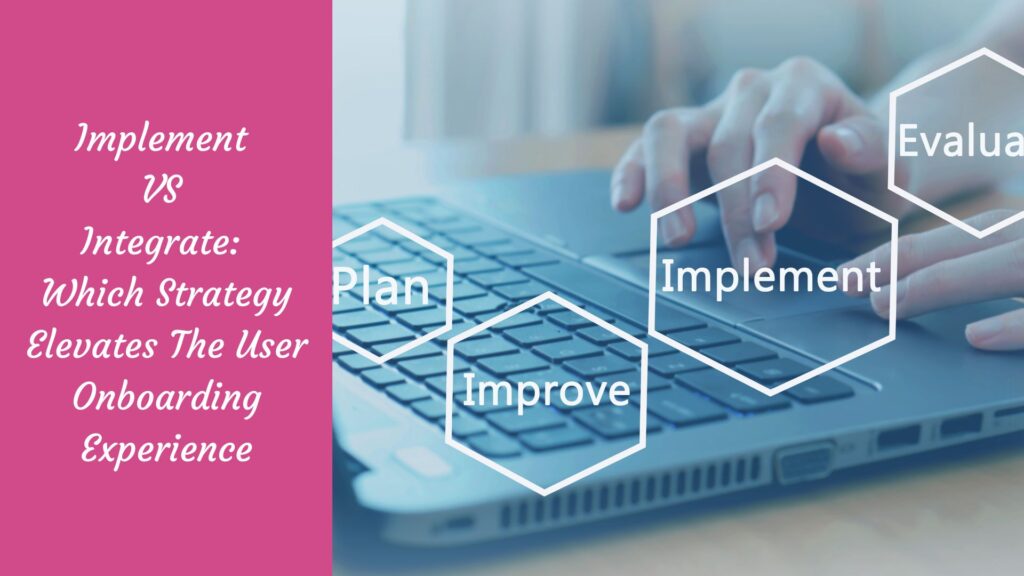In a world where the user experience (UX) can make or break a product’s success, the onboarding process takes center stage. But here’s the burning question: should we meticulously implement a thoughtfully designed onboarding process or seamlessly integrate the user’s path into the product’s functionalities? 🤔
Get ready for a post that demystifies the pros and cons of implement vs integrate strategies, offering valuable insights for businesses to tailor their onboarding experience. Let’s dive in! 💡
What is Software Implementation?
Software implementation refers to the process of installing new software and ensuring its proper function within an existing system or standalone environment. It involves several stages, such as planning, installation, testing, and user training.

- Planning: This is the initial stage where businesses analyze their needs, set objectives, and develop a timeline for software implementation. For instance, a retail business planning to implement inventory management software would outline its specific needs, such as real-time stock tracking, automated ordering, and sales reports.
- Installation: This stage involves setting up the software in the system. It could include activities like server setup, database configuration, and software installation on the requisite machines. Using the earlier example, this would involve installing the inventory management software on all necessary devices within the retail store.
- Testing: Post-installation, it’s crucial to test the software for any potential glitches or errors. The retail business would run multiple scenarios to ensure the inventory software is accurately tracking stock levels and generating correct reports.
- User Training: Finally, businesses need to train staff on how to use the new software effectively. In our example, the retail employees would be trained on how to input new inventory data, read stock levels, and generate sales reports.

By following these steps, businesses can successfully implement software, ensuring it meets their specific needs and enhances operational efficiency.
What is Software integration?

Software integration, in contrast to implementation, refers to the process of combining different software systems, making them work cohesively to optimize business processes, improve data flow, and enhance user experience. Integration is often a complex process involving several stages:
- Assessment: This initiates the integration process and involves identifying the systems to be integrated, understanding their functionalities, and drawing up a plan for the integration. For instance, a company may want to integrate its CRM (Customer Relationship Management) tool with its email marketing system to streamline customer communications.
- Design: Here, businesses outline how the systems will interact. Using the previous example, they’ll determine how data, like customer contact information, flows from the CRM to the email marketing system. An efficient design will ensure seamless data transfer and minimal disruption to existing workflows.
- Execution: This stage includes the actual integration of systems. It could involve writing custom code or using integration software. In the CRM and email marketing example, the execution stage would involve setting up the transfer of data, ensuring that when a new customer is added to the CRM, their information is also added to the email marketing system.
- Testing: Similar to implementation, testing in integration is crucial. It would involve ensuring that data transfer between the CRM and email marketing system is working correctly, with no data loss or errors.
- Maintenance: Post-integration, it’s imperative to monitor the integrated systems for any issues and to ensure they’re working as intended. I could involve regular checks or automated reporting.

While software integration can be complex, when done correctly, it can greatly enhance operational efficiency, data consistency, and user experience. By allowing different systems to communicate and share information, integration can create a more seamless and intuitive user experience, aiding in successful user onboarding.
Software Implementation vs Integration: Who Wins The Game

While both implement vs integrate processes play integral parts in enhancing the user experience, they serve distinct purposes, and their effectiveness can vary based on the specific needs of a business. 🧩
For instance, a startup launching its first product might prioritize a thorough implementation strategy. 🚀
They would focus on setting up an individual software to address a specific need, like customer relationship management (CRM), ensuring it’s installed and tested and that users are well-trained on its usage. 💡

This strategy is akin to laying a firm foundation upon which the startup can build as it expands. 🏗️
On the other hand, a mature company with several software systems running simultaneously might prioritize integration. 🔗
They could aim to link their CRM with other software like marketing automation platforms or customer support tools, creating a seamless flow of data that enhances efficiency and delivers a superior user experience. 🌟
This approach is akin to crafting a network of well-connected roads, ensuring smooth and efficient traffic flow. 🛣️
To illustrate:
- Implementation: An e-commerce startup focusing on selling handcrafted items implements a CRM tool to handle customer interactions. They invest time in training their team to use the CRM effectively, ensuring every customer query is addressed promptly and accurately. The focus here is on establishing a strong foundation for customer service.
- Integration: After a year, the startup has grown. They’ve added an email marketing tool to their software suite, and they decided to integrate it with their CRM. Now, when a customer makes a purchase, their details are automatically added to the email marketing tool, streamlining the process of sending them promotional materials and updates.
So, who wins the game – software implement vs integrate? 🤔 The answer is neither and neither. It’s not about choosing one over the other but understanding when to focus on implementation and when to shift towards integration.
A well-executed blend of both strategies can help businesses elevate their user onboarding experience, leading to increased user satisfaction and long-term success. ✨🚀
How Software Implementation vs Integration can Help Create Better User Onboarding Experience
When it comes to improving the user onboarding experience, both software implementation and integration play pivotal roles. Let’s further delve into how these two strategies can be used in unison to streamline the onboarding process. ✨🚀

1. Structured and Interactive Training through Implementation:
User onboarding begins with the effective implementation of different software. For instance, a project management tool like Asana or Jira can be implemented to assign tasks and manage workflows.
Here, the implementation phase would involve organizing a series of interactive training sessions for users. It allows them to understand the tool’s features, its operation, and how it can assist them in their daily tasks. The intention is to ensure that users are comfortable with the interface and understand the tool’s potential benefits, thereby increasing adoption rates.
2. Seamless Workflow through Integration:
Once the users are well-acquainted with a tool, businesses can elevate the user experience by integrating it with other software systems. For example, the project management tool, once used in isolation, can be integrated with a communication tool like Slack.
This integration enables users to receive immediate notifications about task updates within their communication platform, eliminating the need to switch between applications constantly. It not only simplifies the workflow but also empowers users to handle tasks more efficiently.
3. Enhanced Data Accessibility:
A prime example of the power of integration can be seen in the integration of CRM software like Salesforce with an analytics tool like Tableau.
Once implemented individually and users are trained on each, integrating these tools can provide users with real-time access to customer data and the ability to analyze these data visually. This integration enhances data accessibility, makes it easier for users to understand and interpret data, and ultimately boosts their productivity.
4. Strengthened Communication:
Integration can also improve internal communications, which is crucial during onboarding. Consider the case of a company using the HR platform BambooHR and a communication tool like Microsoft Teams.
Once employees are familiar with both platforms, integrating the two could mean that updates or announcements made in BambooHR automatically appear in Teams. It ensures that all users are informed and aligned, bolstering overall communication. 📢💬
Software implementation and integration work hand-in-hand to improve user onboarding. 🌟
Implementation is instrumental in familiarizing users with new software, while integration creates a seamless, efficient, and productive workflow that enhances the overall user experience. 🚀💻
Recognizing the balance between implementation and integration is key to achieving a successful user onboarding experience. ⚖️🔑
How to Make Software Implementation and Integration Better

To enhance the process of software implementation and integration, businesses can employ a variety of strategies. Here are some practices that may prove beneficial: ✨🚀
1. Prioritize User Experience:
Ultimately, the success of a software implementation or integration can be gauged by the quality of the user experience it delivers. A user-friendly interface, easy navigation, and intuitive functionality are all critical aspects to consider.
For example, before implementing a new CRM tool, consider conducting a survey or focus group to understand what users liked and didn’t like about the previous system. This insight can guide the implementation process, ensuring that the new system is designed with the end user’s preferences in mind.
2. Provide Comprehensive Training:
The value of thorough training should not be underestimated when implementing new software. It includes not just initial training sessions but also refresher courses, best-practice seminars, and providing ongoing access to resources and support.
A point-of-sale business, for instance, might offer in-depth training to its employees on a new inventory management system, supplemented by printed guides at each workstation and regular webinars to address common issues.
3. Opt for Scalable Solutions:
The software solutions businesses choose should ideally be scalable. It means as the business grows, the software can adapt and grow with it without necessitating a complete overhaul.
For instance, a growing e-commerce platform might choose a payment processing system that can handle a relatively low volume of transactions initially but can easily scale to accommodate increased activity as the business expands.
4. Test Before Integration:
To ensure smooth integration, it’s crucial to test each software individually before attempting to integrate them. I can help identify and rectify any issues at an early stage, avoiding potential complications down the line. For example, an online ticketing platform might first test its booking system and customer service chatbot separately before integrating the two.
5. Regularly Review and Update:
The work doesn’t stop once software implementation and integration are complete. Regularly reviewing systems and processes, soliciting user feedback, and making necessary adjustments will keep your software environment up-to-date and ensure it continues to meet the needs of your users and business.
For instance, a digital marketing agency using a social media management tool might review its effectiveness quarterly, taking into account changes in social media algorithms and user feedback to make necessary updates.

By focusing on these strategies, businesses can improve the process of software implementation and integration, leading to enhanced efficiency, better user experience, and, ultimately, greater success.
Conclusion
Software implement vs integrate comparison play a vital role in optimizing business workflows and elevating user experiences. 🚀 By prioritizing user-centricity, providing comprehensive training 🎓, selecting scalable solutions ⚙️, conducting thorough testing ✅, and regularly reviewing and updating systems 🔄, businesses can ensure a seamless onboarding process for their users.
With the right approach, businesses empower users to work more efficiently, boosting productivity and achieving success. 💪 Recognizing the value of these processes and continuously striving for improvement is crucial in today’s digital landscape. Stay ahead of the curve by exploring new software solutions strategically and integrating them, always keeping user experience at the forefront. Let’s embrace the ever-evolving technological landscape together! 🌐

10+ years experience in Marketing and Operations
